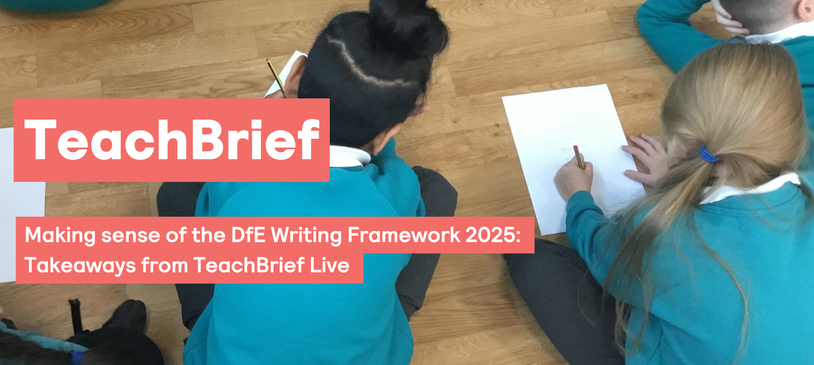At the very first TeachBrief Live, our new national literacy briefing for primary schools, a panel of literacy experts came together to unpack the newly released DfE Writing Framework 2025. The session, hosted by Martin Galway (the National Literacy Trust's Head of Professional Learning and Partnerships), featured education consultants and CPD trainers Catherine Caldwell and Maddy Barnes – who both brought practical expertise from their extensive work in schools.
In this article for TeachBrief, we’ve distilled a summary of the key takeaways, with actionable tips from the panel to support your classroom practice and school-wide strategy. This is for primary teachers, literacy leads, and school leaders looking to implement the framework effectively.
We’ve also provided resources to support implementation, including guidance on the Dictogloss technique (ideal for KS2 writing), plus auditing tools and resources to help build writing culture in your primary school. Find these linked at the end of the article.
Missed out on TeachBrief Live? The next one is coming spring term 2026 -sign up here to be notified when registration opens!

Our recent research shows opportunities for unlocking learner's writing abilities - how can the new writing framework support this?
1. Writing: why is it important now?
The findings from our recent report produced with Oxford University Press present a complex picture of how children and young people experience writing in school.
3 in 4 (73.4%) of pupils considering themselves to be either very good or good writers. However, many (48.5%) prefer clear, structured guidance from teachers on how to plan and compose their writing, while 2 in 5 (43.5%) report struggling with time constraints and deciding what to write (41.6%), while 1 in 3 (36.8%) reported running out of ideas.
Overall, while many children and young people value writing and see its purpose, anxieties around correctness, lack of autonomy, and limited creative freedom can hinder engagement. Alongside supportive guidance, opportunities for choice and meaningful inspiration can help unlock the full potential of writing as a learning tool and form of creative expression.
As our panel explored, the new writing framework offers opportunities to support these needs and maximise pupil's writing abilities.
2. Quality over quantity: A shift in focus
What the framework says: Prioritise the quality of writing over the volume produced.
Catherine Caldwell’s advice:
“Reflect on what it means in terms of quality of writing in your school, not quantity. That’s a key message to take away and embed early.”
Maddy Barnes added:
“To see it in black and white is your license. It’s not about writing loads - it’s about getting the foundations right.”
Practical tip:
- Audit your writing expectations. Are pupils being asked to produce lengthy pieces too soon? Shift focus to short, high-quality writing tasks that build skills progressively.
3. Sentence structure: teach for meaning, not just grammar
What the framework says: Sentence construction should support coherence and cohesion.
Maddy Barnes’ advice:
“Use Appendices D & E to explore how conjunctions change meaning. Ask pupils: ‘Jack needed to sell the beans because/and/but - what are we telling the reader?’”
Catherine Caldwell’s advice:
“Go back to basics. Use the framework to align language and expectations across staff. It’s a launchpad for professional dialogue.”
Practical tip:
- “Use sentence combining activities and other suggestions in Section 4 to teach grammar in context. For example, focus on why a conjunction is used, not just ticking off grammar objectives.”

Meaning and purpose can be a strong motivator for young writers, and contribute to stronger writing abilities.
4. Purpose and audience: make writing meaningful
What the framework says: Writing should be purposeful and directed at an audience.
Catherine Caldwell’s advice:
“Ask: Do children know why they’re writing? Is there always a reason and purpose? That’s what switches them on.”
Martin Galway added:
“We write for it to be read. Are we acknowledging who’s reading this and why it matters?”
Practical tip:
- Embed authentic writing tasks into your curriculum, such as letters, blogs, posters or reviews. Make sure pupils know who they’re writing for and why.
5. Editing and proofreading: teach the skills explicitly
What the framework says: Pupils should be taught to revise, edit, and proofread their writing.
Maddy Barnes’ advice:
“Children won’t just do it. We need to teach them how. Show them sentences that aren’t broken but could be improved.”
She shared a classroom example:
“My pupils would nod and point at their writing, mimicking me. But they weren’t actually revising - they were guessing.”
Practical tip:
- Build a progression model for editing across year groups. Use shared writing to model revision and provide sentence-level examples for improvement.
6. Guided writing: back on the menu
What the framework says: Guided writing is a valid and valuable approach.
Maddy Barnes’ advice:
“Be flexible. If shared writing turns into guided, go with it. It’s about responding to what pupils need.”
Catherine Caldwell’s advice:
“Guided writing isn’t just a session to support children to complete a task - it’s a pedagogy. Use it to target specific learning points and move writing forward.”
Practical tip:
- Use guided writing groups to support pupils with specific needs. Don’t worry about rigid labels—focus on responsive teaching.
7. Whole-school structures: build progression and consistency
What the framework says: Use consistent planning structures across year groups.
Catherine Caldwell’s advice:
“Use simple templates with clear progression. By Year 6, pupils should be able to plan independently because they’ve been taught it over time.”
Practical tip:
- Choose a planning frame (e.g. burger, temple) and use it consistently across KS2. Ensure pupils understand structure before expecting independence.
8. Use what you need: align with your school’s priorities
Maddy Barnes’ advice:
“Don’t feel you have to digest all 150 pages. Prioritise the sections that match your school improvement plan.”
She recommended:
“If handwriting is a bugbear, go straight to the audit on page 37. Use the framework to support what you’re already working on."
Practical tip:
- Map your school development plan against the framework. Use it to enhance, not replace, your existing strategy.

The framework isn't compulsory - but there's opportunities to enhance your writing provision where it's needed most.
Final thoughts
The DfE Writing Framework 2025 is non-statutory, but it offers a wealth of practical guidance. As Martin Galway reminded us:
"You know your children best. Use the framework to enhance what you’re already doing, not to derail it."
In other words: focus on quality, teach writing as a craft, and build a culture where writing matters.
Resources:
Improving Writing in KS2 CPD Developed with the new DfE writing framework, in this CPD you'll explore strategies to help learners take ownership of their writing, build self-assessment skills, and tackle a wide range of text types with confidence – beyond scaffolded exercises.
Everybody Writes: Writing groups A writing group is a great way to establish a writing culture in your school and begin to grow a love of writing for pleasure. The resources provided on this page provide guidance on starting your own writing club, and will help you inspire students to enjoy writing as well as developing skills.
Research into Practice: Write your way This research-informed resource is designed to help you understand the latest findings on writing attitudes and behaviours among children and young people aged 5 to 18, and discover fun ways to explore and inspire writing for pleasure through classroom activities.
